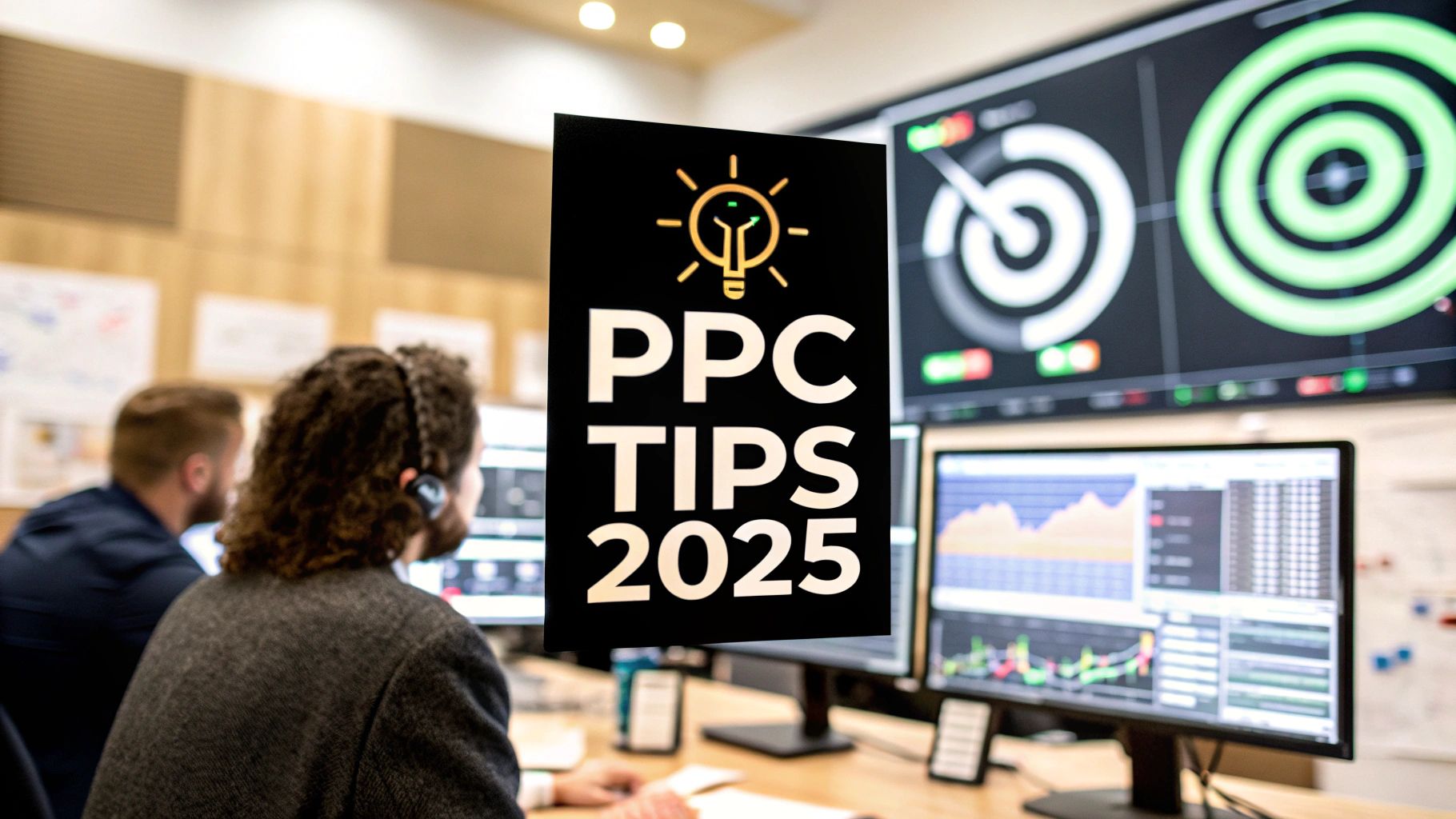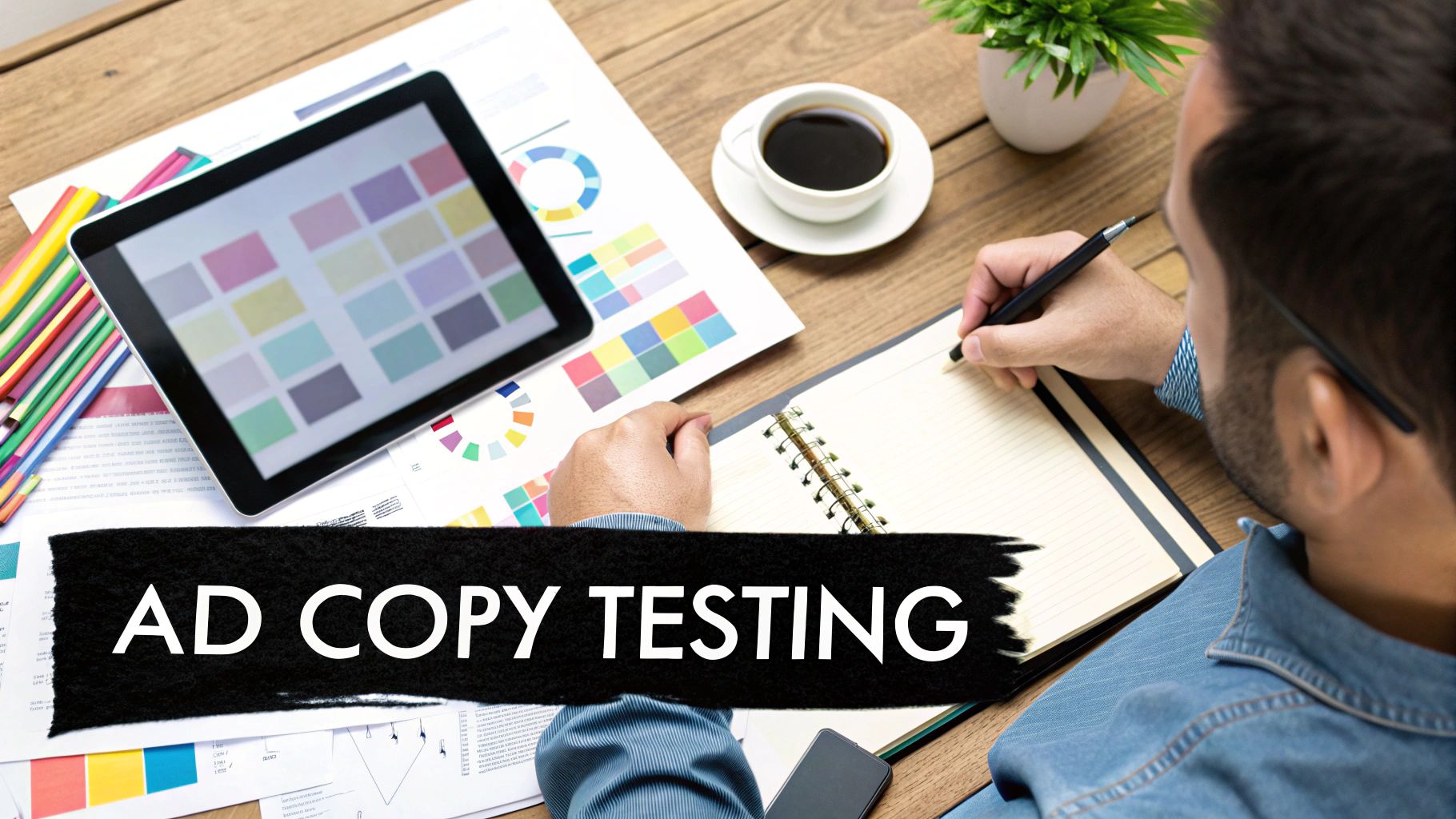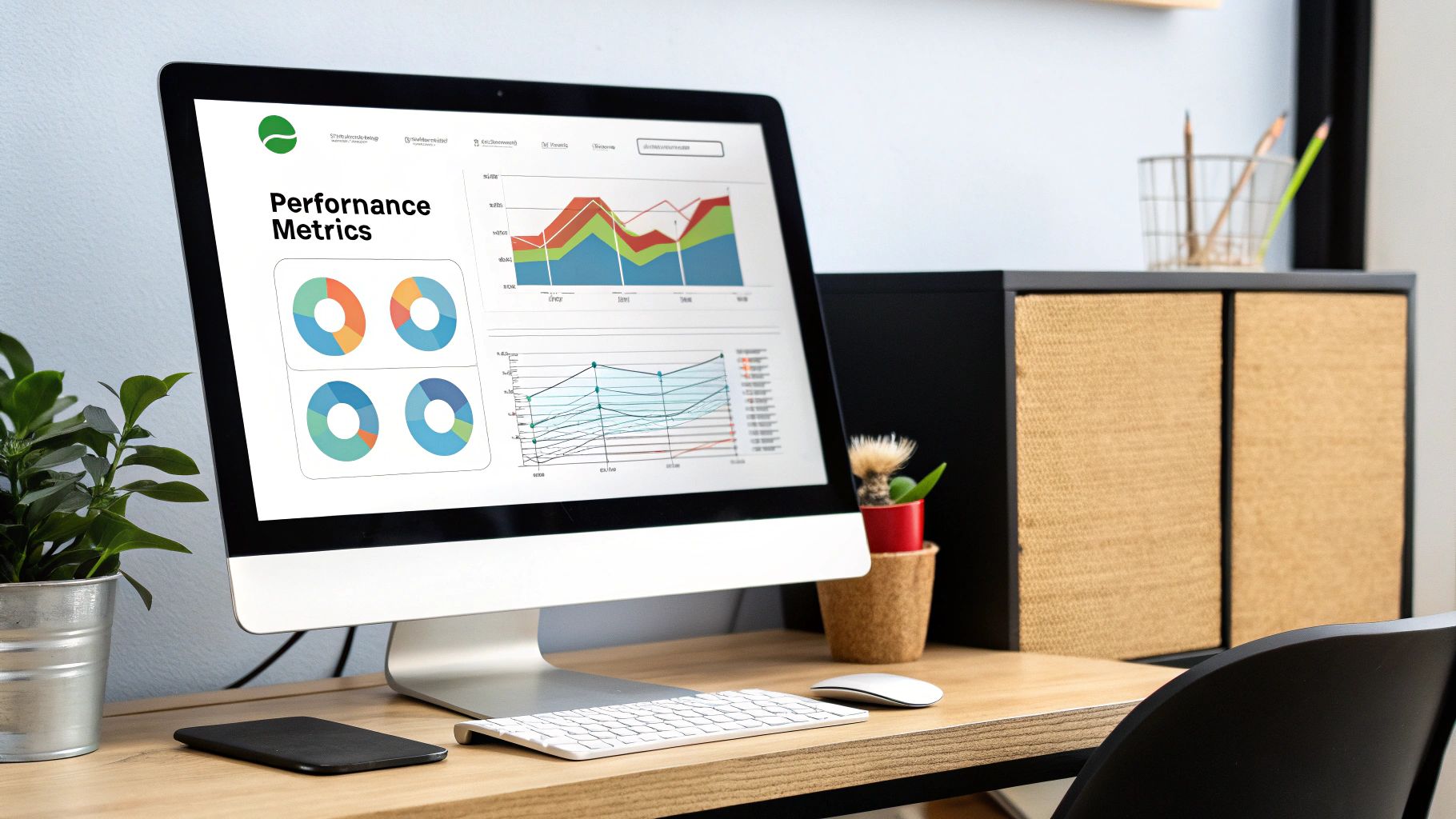July 30, 2025
8 PPC Campaign Management Tips for 2025


Feeling like your PPC budget is a leaky bucket? You're not alone. In today's hyper-competitive digital marketplace, running a successful PPC campaign is more complex than just picking a few keywords and setting a daily spend. It's a dynamic blend of art and science, demanding constant attention, strategic tweaks, and a deep understanding of what makes your audience click. But what if you could turn that ad spend into a powerful, predictable growth engine?
This article cuts straight through the noise. We’re unpacking a comprehensive list of practical, actionable PPC campaign management tips that go far beyond the basics. You'll learn exactly how to refine your campaigns, maximize your ROI, and finally get the results you've been aiming for. From nailing your keyword research and ad copy to mastering bid strategies and audience targeting, these insights are designed for immediate implementation.
As you dive into these strategies, remember that technology can be a massive advantage. Exploring various marketing AI tools can significantly enhance your efficiency, helping you automate tedious tasks and uncover deeper optimization opportunities. We will cover everything from structuring your campaigns for clarity and control to leveraging competitive analysis for a crucial market edge. It's time to stop guessing and start managing your PPC efforts with confidence. Let's get started.
1. Keyword Research and Selection
Think of keyword research as the architectural blueprint for your PPC house. If the foundation is shaky, the whole structure is at risk of collapsing. This fundamental step involves digging deep to uncover the exact search terms your ideal customers are typing into Google. It's about more than just grabbing high-volume terms; it's about understanding the intent behind each search, which is a cornerstone of effective PPC campaign management tips.

This process isn't just a one-and-done task. It’s an ongoing cycle of discovery, analysis, and refinement. By pinpointing the right keywords, you ensure your ads are shown to a relevant audience, which directly translates to higher click-through rates, better Quality Scores, and a stronger return on your ad spend.
How to Nail Your Keyword Strategy
So, how do you put this into practice? Let's look at a real-world example. A brand like Nike doesn't just bid on "shoes." They get granular. They target broad terms like "women's running gear" to capture top-of-funnel interest, but they also zero in on hyper-specific product keywords like "Nike Air Max 270 white size 9" to attract buyers who are ready to purchase.
Here are some actionable tips to build a powerful keyword list:
- Balance Your Portfolio: Don't put all your budget on highly competitive, high-volume keywords. Mix in long-tail keywords (three or more words) like "best waterproof hiking boots for wide feet." These often have lower competition, are less expensive, and carry much higher conversion intent.
- Structure with Themed Ad Groups: Don't just dump all your keywords into one ad group. Create tightly-themed ad groups with 5-20 closely related keywords. For example, have separate ad groups for "tennis shoes," "running shoes," and "basketball sneakers." This allows you to write highly relevant ad copy for each specific search.
- Leverage Pro Tools: While Google Keyword Planner is a great starting point, tools like SEMrush and Ahrefs offer deeper competitive insights and more extensive keyword suggestions to flesh out your strategy. You can even find ways to automate keyword research and streamline your workflow.
- Master the Negative Keyword List: This is your secret weapon against wasted spend. Regularly review your search term report to find irrelevant queries that trigger your ads. Add them to your negative keyword list to prevent your ads from showing for those terms again.
2. Ad Copy Optimization and A/B Testing
If your keywords are the blueprint, then your ad copy is the curb appeal that invites people inside. You can have the best-targeted keywords in the world, but if your ad message is flat, uninspired, or irrelevant, your ideal customers will scroll right past. Ad copy optimization is the art and science of crafting compelling messages that resonate with searchers' immediate needs and motivations, a vital part of any list of effective PPC campaign management tips.

This isn't just about being a creative wordsmith. It's about a relentless process of testing, learning, and refining. By constantly A/B testing your headlines, descriptions, and calls-to-action, you can systematically improve your click-through rate (CTR), boost your Quality Score, and ultimately drive more conversions without necessarily increasing your bids.
How to Craft and Test Winning Ad Copy
So how do you turn basic ads into high-performing click magnets? Let's look at how big brands do it. Spotify doesn't show the same ad to a metalhead and a classical music aficionado. They use personalized copy that speaks directly to different tastes, like "Your ultimate death metal playlist awaits" versus "Discover calming classical for focus." This level of relevance is what makes users click. Similarly, Airbnb uses location-specific copy highlighting local landmarks to make their ads feel more personal and trustworthy for travelers.
Here are some actionable tips for powerful ad copy and testing:
- Test One Element at a Time: Want to know if a new headline works? Don't change the description at the same time. By isolating one variable, like the headline, description, or call-to-action, you can get clean data that tells you exactly what moved the needle.
- Include Keywords in Headlines: This is a classic for a reason. Including the user's search query in your headline (especially Headline 1) immediately signals relevance and can significantly improve your ad's performance and Quality Score.
- Use Strong Calls-to-Action (CTAs): Go beyond "Click Here." Use action-oriented language that communicates value or urgency. Phrases like "Shop Now & Get 20% Off," "Download Your Free Guide," or "Get a Free Quote Today" tell users exactly what to expect and why they should act.
- Leverage Ad Extensions: Maximize your ad's screen real estate. Sitelinks, callouts, and structured snippets add valuable information and give users more reasons to click your ad over a competitor's, effectively boosting your CTR for free.
- Ensure Message Match: Your ad copy sets a promise, and your landing page must deliver on it. If your ad promotes a "50% off sale," the landing page needs to feature that sale prominently. A disconnect here is a fast track to high bounce rates and wasted spend.
3. Landing Page Alignment and Optimization
Think of your PPC ad as the promise and your landing page as the fulfillment of that promise. If a user clicks an ad for "waterproof hiking boots" and lands on a generic homepage for outdoor gear, the connection is broken. This disconnect is where conversions go to die, which is why landing page alignment is one of the most critical ppc campaign management tips you can implement.

This process is about creating a seamless, frictionless journey from the ad click to the conversion. By ensuring your landing page directly reflects the ad's message, keywords, and offer, you meet user expectations head-on. This not only dramatically improves your conversion rates but also boosts your Google Ads Quality Score, leading to lower costs per click and better ad positions.
How to Nail Your Landing Page Strategy
So, how do you build this crucial bridge between ad and page? Let's look at a brand like Slack. They don't send all traffic to one page. They create dedicated landing pages for different user segments, such as "Slack for small businesses" or "Slack for enterprise," ensuring the messaging and features highlighted are hyper-relevant to the ad that was clicked.
Here are some actionable tips to build a powerful landing page experience:
- Create Unique Pages for Ad Groups: Don't use your homepage as a catch-all. For each tightly-themed ad group, create a dedicated landing page. If you have an ad group for "red running shoes," the landing page should exclusively feature red running shoes.
- Mirror Your Ad Copy: The headline on your landing page should closely match or be identical to the headline in your ad. If your ad says, "50% Off Your First Order," that exact offer needs to be the first thing a user sees on the page.
- Optimize for Speed and Experience: A user's patience is thin. Ensure your page loads in under three seconds. The design should be clean, mobile-responsive, and guide the user's eye directly to a single, clear call-to-action (CTA) button.
- Test Everything: Never assume you know what works best. Use A/B testing tools to experiment with different headlines, images, CTA button colors, and page layouts. Even small changes can lead to significant lifts in conversion rates.
4. Bid Management and Budget Optimization
Think of bid management and budget optimization as the gas pedal and fuel gauge of your PPC vehicle. You need to apply the right pressure at the right time without running out of fuel before you reach your destination. This crucial element of PPC campaign management tips involves strategically controlling how much you pay per click and how you allocate your total budget to squeeze every drop of value from your ad spend.

This isn't about simply setting a daily budget and hoping for the best. It's an active process of making data-driven decisions. Whether you’re using manual adjustments or leaning on powerful automated strategies, the goal is to direct your funds toward the keywords, audiences, and times of day that deliver the highest performance, ensuring maximum return on investment.
How to Master Your Bids and Budget
Let's look at how the pros handle this. A massive e-commerce player like Target doesn't use the same bidding strategy year-round. During the holiday shopping frenzy, they might use Enhanced CPC bidding to aggressively capture revenue from high-intent shoppers. In contrast, a service like Zillow uses dayparting to increase bids during peak home-searching hours in the evenings and on weekends, maximizing visibility when their audience is most active.
Here are some actionable tips to refine your bidding and budget strategy:
- Walk Before You Run: Start new campaigns with Manual CPC bidding. This gives you granular control and helps you gather initial performance data to understand what's working. Once you have a steady stream of conversions, you can transition to an automated strategy like Target CPA or Maximize Conversions with more confidence.
- Track Everything First: Automated bidding strategies like Target ROAS (Return on Ad Spend) are only as smart as the data you feed them. Ensure you have robust conversion tracking set up before you flip the switch. Without accurate conversion data, the algorithm is just guessing.
- Use Smart Bid Adjustments: Don't let the automation do all the work. Layer on bid adjustments for your top-performing segments. If you see that mobile users in a specific city convert at a 20% higher rate, apply a positive bid adjustment to that segment to capitalize on it.
- Watch Your Impression Share: Regularly check your "Impression Share Lost (Budget)" metric. If this number is high, it’s a clear sign that your budget is too low for your keywords and settings, causing you to miss out on valuable clicks. This is a great starting point for making budget allocation decisions. You can learn more about the different bidding strategies available and when to use them to further enhance your campaigns.
5. Campaign Structure and Organization
Think of your PPC account structure as the filing system for your entire advertising operation. If it's a chaotic mess, finding what you need, making precise adjustments, and understanding performance becomes a nightmare. A logical structure is the backbone of efficient PPC campaign management, allowing for granular control, clear reporting, and scalable growth. It’s about creating a hierarchy that mirrors your business goals, not just your keywords.
This foundational setup dictates how effectively you can manage budgets, target audiences, and optimize ad copy. A well-organized account allows you to isolate variables, test with precision, and allocate your ad spend where it will have the most impact. It’s the difference between a finely-tuned marketing engine and a sputtering, inefficient money pit.
How to Build a Scalable Campaign Structure
So, how do you organize this for maximum impact? Let’s look at a powerhouse like Amazon. They don't just have one campaign for "books." They likely have separate campaigns for brand keywords ("Amazon Kindle"), generic terms ("e-readers"), competitor terms ("Barnes & Noble Nook"), and even campaigns segmented by product line, like "Prime Video" versus "Amazon Web Services." Each has its own budget, targeting, and goals.
Here are some actionable tips to build a powerful campaign structure:
- Separate Brand vs. Non-Brand: This is non-negotiable. Create separate campaigns for your brand keywords and for generic, non-branded keywords. Brand searches have completely different intent, performance metrics, and cost-per-click. Mixing them pollutes your data and prevents effective budget allocation.
- Group by Theme, Not Just Keywords: Structure your campaigns around your product categories, services, or business lines. An e-commerce store like REI would have distinct campaigns for "Camping Tents," "Hiking Boots," and "Climbing Gear." This allows you to set specific budgets and write highly relevant ads for each category.
- Use Consistent Naming Conventions: Implement a standardized naming system from day one. A simple format like
[Category] - [Match Type] - [Location](e.g.,HikingBoots - Phrase - USA) makes navigating, filtering, and reporting exponentially easier as your account grows. - Consider Single Keyword Ad Groups (SKAGs): For your highest-value, highest-volume keywords, consider using SKAGs. This involves creating an ad group with just one keyword. This approach offers ultimate control over the ad copy and landing page, ensuring perfect message match and often leading to higher Quality Scores.
6. Performance Tracking and Analytics
Think of performance tracking as the sophisticated GPS and dashboard for your PPC vehicle. Without it, you're driving blind, burning fuel (your budget) without knowing if you're heading toward your destination or just driving in circles. This crucial step involves setting up systems to measure, analyze, and report on campaign data, which is one of the most vital PPC campaign management tips for sustainable growth.
This isn't just about glancing at your clicks and impressions. It's about connecting your ad spend to tangible business outcomes, understanding the customer journey, and making intelligent, data-driven decisions that fuel real results. By implementing robust tracking, you can pinpoint what's working, cut what isn't, and continuously optimize for better performance.
How to Master Your Analytics Framework
So, how do you move from basic metrics to meaningful insights? Let’s look at a real-world example. A company like Wayfair doesn't just track the final click that led to a sale. They use advanced attribution modeling to understand how display ads, social media interactions, and multiple search clicks all contributed to that final purchase, giving them a holistic view of their marketing efforts.
Here are some actionable tips to build a powerful analytics system:
- Set Up Conversion Tracking First: Before you spend a single dollar, ensure your conversion tracking is installed correctly. Whether it's a form submission, a phone call, or an e-commerce purchase, you must be able to measure the actions that matter most to your business.
- Use UTM Parameters for Clarity: Tag all your campaign URLs with unique UTM parameters. This allows you to meticulously track performance across different sources, mediums, and campaigns within tools like Google Analytics, giving you a granular view beyond what the ad platform provides.
- Create Custom Dashboards: Don't get lost in a sea of data. Build custom dashboards in Google Analytics or use tools like Looker Studio (formerly Data Studio) to monitor the key performance indicators (KPIs) that align with your specific business goals, such as Cost Per Acquisition (CPA) or lead quality.
- Audit Your Tracking Regularly: Data accuracy is non-negotiable. Periodically audit your tracking setup to ensure tags are firing correctly and data is being passed accurately. A small tracking error can lead to hugely misguided optimization decisions. Ultimately, the success of your PPC campaigns is measured by their return on investment. For a comprehensive guide on evaluating and boosting your marketing ROI, you can explore more advanced strategies.
7. Audience Targeting and Remarketing
Think of audience targeting as the VIP guest list for your digital party. You wouldn't invite just anyone; you want to reach the people who are most likely to enjoy the event, engage with others, and maybe even bring a gift (in this case, a conversion). This strategy goes beyond keywords to focus on who sees your ads, using demographic, behavioral, and intent data to serve hyper-relevant messages. It’s a core component of modern PPC campaign management tips, transforming your campaigns from a broad shout to a personal whisper.
This isn't about casting the widest net possible. It's about precision. By layering audience signals, you can connect with users who have previously interacted with your brand (remarketing) or people who exhibit behaviors and interests that align with your ideal customer profile. This ensures your budget is spent on the most promising prospects, dramatically improving efficiency and ROI.
How to Master Your Audience Strategy
So, how do you move from theory to practice? Consider how a company like Expedia uses it. If you browse flights to Hawaii but don't book, you’ll likely see ads featuring stunning Hawaiian beaches and limited-time hotel deals. They aren't just targeting "vacations"; they're retargeting you based on your specific demonstrated interest, nudging you toward conversion.
Here are some actionable tips to build a powerful audience targeting framework:
- Build Granular Remarketing Lists: Don't settle for one "all visitors" list. Create specific lists based on user actions. Segment users who abandoned a shopping cart, viewed a specific product category, or spent more than three minutes on your pricing page. This allows for incredibly tailored ad creative.
- Use Exclusions Strategically: Audience targeting is as much about who you don't target. Exclude existing customers from new acquisition campaigns to avoid paying for clicks from people who have already converted. Similarly, exclude low-value remarketing lists from high-bid campaigns to focus your spend.
- Tailor Messaging to Audience Segments: A new visitor needs a different message than someone who abandoned a cart. For new users, focus on your brand's unique value proposition. For cart abandoners, create a sense of urgency with offers like "Complete your purchase now for 10% off!"
- Leverage In-Market and Affinity Audiences: Go beyond your own site visitors. Use Google's in-market audiences to find users actively researching products or services like yours. Affinity audiences help you reach people based on their long-term interests and lifestyle, which is perfect for building brand awareness. For a deeper dive into these options, you can learn more about Google Ads audience targeting on keywordme.io.
8. Competitive Analysis and Market Intelligence
Think of your competitors not as obstacles, but as free sources of market research. PPC isn't a solo sport; you're competing in a live auction against other businesses vying for the same clicks. Competitive analysis is your playbook for understanding their strategies, allowing you to sidestep their strengths, exploit their weaknesses, and find untapped opportunities. It's one of the most crucial PPC campaign management tips for gaining a strategic edge.
This process involves more than just a quick glance at who else shows up for your main keywords. It’s a deep dive into your rivals' ad copy, landing pages, keyword selection, and bidding patterns. By understanding the competitive landscape, you can make smarter decisions, avoid costly bidding wars, and position your brand to win over customers who are actively comparing their options.
How to Leverage Competitive Intelligence
So, how do you ethically spy on your competition? Let's consider a real-world scenario. A brand like Shopify doesn't operate in a vacuum. It continuously monitors what competitors like BigCommerce and WooCommerce are doing. They analyze which keywords these rivals are bidding on, what messaging they use in their ads (e.g., "easiest setup" vs. "most customizable"), and what their landing page experience looks like. This intelligence helps Shopify refine its own value proposition and ad copy to stand out.
Here are some actionable tips for conducting effective competitive analysis:
- Use Specialized Tools: Platforms like SEMrush, SpyFu, and iSpionage are purpose-built for this. They allow you to see your competitors' estimated ad spend, top-performing keywords, historical ad copy, and more. This data provides a powerful starting point for your own strategy.
- Analyze Impression Share: Dive into your Google Ads Auction Insights report. This report shows you who you’re competing against most frequently and how often you’re outranking them. If a specific competitor's impression share is rising, it's a signal to investigate their strategy more closely.
- Look for Strategic Gaps: Your competitors can't be everywhere at once. Use analysis tools to find valuable keywords they aren't bidding on or customer segments they are ignoring. These gaps represent low-competition, high-potential areas for you to dominate. To develop a robust strategy and truly stand out, consider leveraging a comprehensive B2B competitive analysis framework.
- Adapt, Don't Copy: If you see a competitor running a successful campaign, don't just clone it. Understand why it works. Are they using a compelling offer? Is their ad copy resonating with a specific pain point? Adapt the underlying principle to your own brand voice and unique selling proposition.
PPC Campaign Management: 8 Tips Comparison
Your Next Move: From Tips to Transformation
Alright, let's take a breath. We’ve just navigated a serious deep dive into the world of PPC, covering everything from the nitty-gritty of keyword research to the high-level strategy of competitive analysis. It’s a lot to absorb, but here’s the most important thing to remember: PPC success isn’t about finding one magic bullet. It’s about building a machine. Each of the PPC campaign management tips we've discussed is a critical gear in that machine.
Think of it this way. Your campaign structure is the chassis, giving everything a solid foundation. Your keyword strategy and match types are the engine, determining your power and reach. Your ad copy and landing pages are the steering wheel and tires, directing that power precisely where it needs to go. And your budget controls and analytics? That’s your dashboard, giving you real-time feedback so you can adjust course, hit the gas, or ease off the brakes. When all these parts work in harmony, you don’t just have a campaign, you have a predictable, scalable growth engine for your business.
The Real Takeaway: From Passive to Proactive
If you walk away with just one thing today, let it be this: shift from being a reactive campaign manager to a proactive one. Don't wait for your Cost Per Acquisition (CPA) to skyrocket before you investigate your landing page experience. Don't wait for your Click-Through Rate (CTR) to tank before you start A/B testing new ad copy. The most successful PPC specialists are constantly tinkering, questioning, and optimizing. They treat their campaigns like a living, breathing ecosystem that requires consistent attention and care.
This proactive approach is where the real value lies. It’s the difference between running ads and truly managing a PPC strategy. By consistently implementing these PPC campaign management tips, you're not just tweaking settings; you're building a powerful feedback loop.
- You test an ad variation. The data tells you what message resonates.
- You segment an audience. The results show you who your most valuable customers are.
- You add a negative keyword. You stop wasting money and improve your lead quality.
Each action provides an insight, and each insight informs your next action. This cycle of implement, measure, learn, repeat is the absolute core of effective PPC management.
Your Action Plan for Tomorrow
Feeling overwhelmed? Don't be. You don't need to implement all of these tips by lunchtime tomorrow. The goal is progress, not perfection. Here’s a simple, actionable plan to get started:
- Pick ONE Area: Choose the single tip from this article that resonated most with you. Is your campaign structure a mess? Start there. Have you never looked at a competitor’s ads? Make that your priority.
- Set a Small, Specific Goal: Don't just say "I'll optimize my ad copy." Instead, say "This week, I will write two new headlines for my top-performing ad group and launch an A/B test."
- Block Out the Time: Put 60 minutes on your calendar. Protect that time like it's your most important meeting of the week, because when it comes to your ROI, it just might be.
- Execute and Review: Run your test, analyze your search terms, or rebuild that one ad group. Then, at the end of the week, look at the initial data. You'll not only see the impact but also build the momentum needed to tackle the next tip on the list.
Mastering PPC is a journey, not a destination. The landscape is always changing, with new features, different competitor tactics, and shifting user behavior. But the principles we’ve covered, data-driven decision-making, relentless testing, and strategic organization, are timeless. By committing to this process of continuous improvement, you’ll turn your ad spend from an expense into your most powerful investment.
Ready to put these PPC campaign management tips into practice without getting bogged down by the tedious, manual work? Keywordme automates critical tasks like finding negative keywords and discovering new expansion opportunities, freeing you up to focus on the high-level strategy that truly drives growth. Stop drowning in spreadsheets and start making smarter, faster decisions by visiting Keywordme today.


.svg)